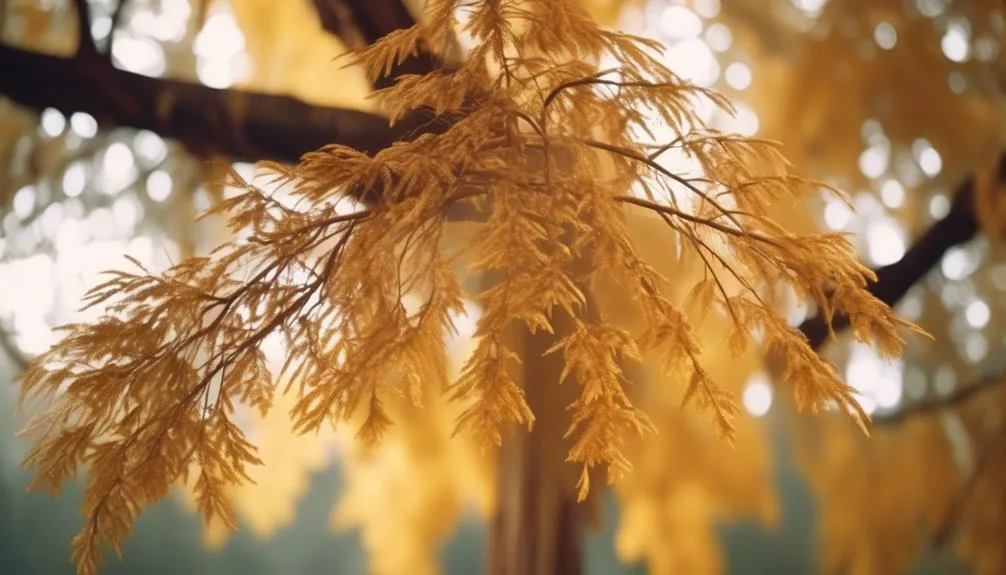Redwood trees, also known as Sequoia sempervirens, are among the tallest and oldest tree species globally. One common sight is redwood trees shedding their leaves.
Have you ever wondered why this happens? Understanding the reasons behind leaf drop in redwood trees can provide valuable insights into their overall health.
Let's explore the intriguing phenomenon of leaf drop in redwood trees and uncover the mysteries behind this natural process.
Leaf Drop in Redwood Trees
Understanding the reasons behind leaf drop in redwood trees can provide valuable insights into the health and maintenance of these majestic giants.
Environmental stress, such as drought, excessive heat, or pollution, can trigger redwood trees to shed their leaves as a survival mechanism. When redwoods experience environmental stress, they prioritize conserving water and energy, leading to leaf drop as a protective measure.
Monitoring leaf drop patterns can offer crucial clues about the overall health of redwood trees. Sudden or excessive leaf drop may indicate significant environmental challenges or underlying health issues that need attention.
Factors Affecting Leaf Drop
If you noticed a sudden or excessive leaf drop in the redwood trees around you, it's essential to explore the various factors that contribute to this phenomenon. Understanding the causes of leaf drop can help you assess the environmental impacts and take appropriate measures to support the trees.
Consider the following factors:
- Seasonal Changes: Redwood trees naturally shed leaves in the fall as part of their annual cycle.
- *Imagery*: Visualize the vibrant colors of the changing leaves as they prepare to fall, creating a beautiful natural spectacle.
- Drought Conditions: Extended periods of low moisture can stress redwood trees, leading to leaf drop.
- *Imagery*: Envision the parched soil and the struggle of the trees to retain their foliage during dry spells.
- Pest Infestations: Insect pests can weaken redwood trees, causing them to shed leaves prematurely.
- *Imagery*: Imagine the impact of pests on the health of the trees, leading to leaf loss.
Seasonal Leaf Drop Patterns
Seasonal leaf drop patterns in redwood trees exhibit a distinct rhythm, influenced by environmental cues and the natural life cycle of the trees. Redwoods typically undergo leaf drop in the late summer to early fall, shedding older leaves to make way for new growth. This process is crucial for tree health, allowing the redwoods to conserve energy and resources during the colder months.
Environmental conditions such as temperature, daylight hours, and moisture levels play a significant role in triggering leaf drop. As daylight hours decrease and temperatures cool, redwood trees respond by entering a period of dormancy, leading to the shedding of leaves.
Understanding these seasonal leaf drop patterns is essential for monitoring the health of redwood trees and ensuring they thrive in their natural environment.
Identifying Abnormal Leaf Drop
When observing redwood trees, pay close attention to any sudden or premature leaf drop, as this can indicate underlying issues affecting the tree's health.
To identify abnormal leaf drop, look for:
- Leaves turning brown or yellow before falling, signaling potential stress factors such as drought or disease.
- Imagine the striking contrast of vibrant green leaves transitioning to dull, lifeless colors.
- Clusters of leaves dropping at once, rather than a gradual shedding, which could be a sign of root damage or nutrient deficiencies.
- Picture a sudden cascade of leaves, hinting at an urgent need for tree health assessment.
- Excessive leaf drop outside of the usual seasonal patterns, requiring a closer look and possible professional diagnosis to uncover the underlying causes.
Managing Leaf Drop Stress
To mitigate leaf drop stress in redwood trees, carefully assess the tree's environment and implement appropriate watering and nutrient management techniques. Proper watering is crucial in managing leaf drop stress. Redwoods require deep, infrequent watering to encourage deep root growth and prevent moisture-related stress. Additionally, addressing any nutrient deficiencies can help alleviate leaf drop. Below is a simple guide to help you manage watering and nutrient deficiency:
| Watering Tips | Nutrient Management |
|---|---|
| – Water deeply and infrequently to promote deep root growth. | – Test the soil to identify any nutrient deficiencies. |
| – Use mulch to retain soil moisture. | – Consider using a balanced fertilizer to address any deficiencies. |
| – Adjust watering frequency based on weather conditions. | – Consult with a local arborist for specific nutrient recommendations. |
Conclusion
In summary, understanding the natural leaf drop of redwood trees is crucial for their long-term health. By monitoring seasonal patterns and addressing any signs of stress, you can support the vitality of these majestic trees.
Embracing leaf drop as a normal part of their cycle is key to nurturing thriving redwood ecosystems.
Mark Hoffman is a dedicated arborist and tree care specialist with over a decade of experience. His love for trees began when he visited Yosemite National Park as a teenager and was awestruck by the giant sequoias. Mark pursued his passion by studying forestry at Michigan Technological University, where he earned a Bachelor of Science degree.
Since then, he has worked tirelessly in the field of arboriculture, helping to preserve and protect trees in his community. His expertise and dedication have made him a respected leader in the industry and a valuable resource for anyone seeking advice on tree care.
